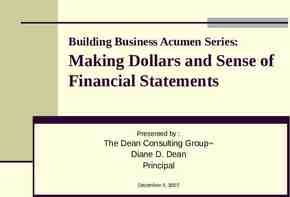Retirement on the Brain® Basics of the Financial Markets Presented
20 Slides1.00 MB

Retirement on the Brain Basics of the Financial Markets Presented by StanCorp Equities, Inc., member FINRA

Presented by [Presenter’s name] [Presenter’s title] [Presenter’s name] [Presenter’s title]

Being ready In this workshop you will learn about: Investment markets The Dow and other market indexes Investment categories Investment options Timing the market Timing in the market Basics of the Financial Markets

What are the markets anyway? Securities are traded in facilities or online: New York Stock Exchange (NYSE) National Association of Securities Dealers Automated Quotations (NASDAQ) London Stock Exchange Tokyo Stock Exchange Basics of the Financial Markets

Why is the Dow a media darling? Leading market indicator Barometer (index) of nation’s financial mood Gauge of investment performance One of oldest continuing U.S. market indexes Basics of the Financial Markets You can’t invest in an index such as the Dow; however, you can use indexes to gauge the performance of all types of investments.

Learning more about the Dow Created in 1896 by Charles Dow Tracks 30 large companies – a “who’s who” of American businesses American Express Boeing Coca-Cola ExxonMobil General Motors Home Depot IBM McDonalds Wal-Mart 1 Significant Closing Dates Date First Close Over Nov. 14, 1972 1,000 points Nov. 21, 1995 5,000 points March 29, 1999 10,000 points July 19, 2007 14,000 points In addition to periods of positive performance, the Dow also experiences periods of loss. Learn more about the Dow online at www.dowjones.com. Basics of the Financial Markets

What about other indexes? Standard & Poor’s 500 Index Performance of broad U.S. stock market Large-company segment 500 leading companies in all major industries S&P 500 Index top 10 companies Apple Inc. Microsoft Corp. Amazon.com Inc. Facebook Inc. Class A JPMorgan Chase & Co. Berkshire Hathaway Class B Johnson & Johnson Alphabet Inc. Class C Alphabet Inc. Class A Exxon Mobil Corp Morningstar 3/13/18 Basics of the Financial Markets

What about other indexes? Russell 2000 Index Performance of U.S. small-company market 2,000 companies; market capitalization less than 1 billion Morgan Stanley Capital International Europe, Australasia and Far East (MSCI EAFE) Developed markets of the world, not including the United States 21 individual country indexes International stock benchmark Basics of the Financial Markets

What about other indexes? Barclays Capital Aggregate Bond Index Broad U.S. investment-grade bond market Government, corporate and mortgage-backed loans 9

What about investment categories? Three most common investment options: Cash equivalents: Low risk and returns Bonds: Moderate potential return and less risk of principal loss than stocks Stocks: Highest potential return — and the most risk to principal (the amount invested) Basics of the Financial Markets

Cash equivalents Investment category Description Cash equivalents Includes money market or stable value Designed to maintain value that does not fluctuate How investors can make money Interest income and return of invested principal How investors can lose money Issuer defaults or returns only a portion of the amount invested Basics of the Financial Markets

Bonds Investment category Description How investors can make money How investors can lose money Bonds Companies, the government, etc., issue bonds to raise money. Purchasing a bond lending your money to the bond issuer for a certain period of time Interest paid to investors Sell bond before maturity for more than purchase price Sell bond before maturity for less than purchase price. Bond issuer has financial problems; can’t repay debt. As interest rates rise, the prices of bonds fall Basics of the Financial Markets

Stocks Investment category Description How investors can make money How investors can lose money Stocks Shares of stock (equities) part ownership of the company Companies sell their stock to investors to raise money Sell shares for more than your purchase price Regular dividends from company earnings and profit Sell shares for less than your purchase price If company goes bankrupt, you could lose entire amount invested Basics of the Financial Markets

What about investment options? Mutual funds are a common type of investment option: Purchases shares, creates portfolios, sells shares of portfolio to investors Sometimes focus on sector (health care, real estate) – sometimes on company size (large cap, mid cap) Your plan may be funded by a mutual fund trust or a group annuity contract. Both are suitable for long-term investing, including saving for retirement. While annuities generally provide tax-deferred treatment of earnings, the group annuity contract does not provide any additional tax-deferred treatment beyond that provided by your retirement plan. Basics of the Financial Markets

What about investment options? Most mutual funds are automatically diversified among a number of individual securities.* Some securities may not perform as well as expected Some securities may perform better than expected Losses may be offset by gains * Diversification does not ensure a profit or protect against a loss in a declining market. Basics of the Financial Markets

Why not ‘time the market’? Timing the market – chasing returns by moving money around based on where the profits are has a tendency to backfire: You’re likely to buy high The characteristics that enable dramatic market growth also allow for surprising declines. You could lose big if the trend turns The moral is simple: Stick to a strategy that’s right for you, and don’t get caught in the chase. Basics of the Financial Markets

When is a good time to be in the market? Source: Standard & Poor’s historical data and The Standard’s internal calculation, 2013. This illustration is hypothetical and for illustrative purposes only and is not indicative of the performance of any specific investment. Past performance is no guarantee of future results. Investments are subject to market risk and fluctuate in value. The S&P 500 is an index of 500 widely traded stocks and is considered to represent the performance of the stock market in general. An investment cannot be made directly in an index. Basics of the Financial Markets

Keep learning Online www.morningstar.com www.nyse.com www.nasdaq.com www.dowjones.com Periodicals Money magazine Forbes magazine The Wall Street Journal The “Money” section of USA Today or similar sections of your local paper Basics of the Financial Markets

Thank you!

Employers and plan participants Employers and plan participants should carefully consider the investment objectives, risks, charges and expenses of the investment options offered under the retirement plan before investing. The prospectuses for the individual mutual funds and each available investment option in the group annuity contain this and other important information. Prospectuses may be obtained by calling 877.805.1127. Please read the prospectus carefully before investing. Investments are subject to market risk and fluctuate in value. The Standard is the marketing name for StanCorp Financial Group, Inc., and its subsidiaries. StanCorp Equities, Inc., member FINRA, wholesales a group annuity contract issued by Standard Insurance Company and a mutual fund trust platform for retirement plans. Standard Retirement Services, Inc., provides financial recordkeeping and plan administrative services. Investment advisory services are provided by StanCorp Investment Advisers, Inc., a registered investment advisor. StanCorp Equities, Inc., Standard Insurance Company, Standard Retirement Services, Inc., and StanCorp Investment Advisers, Inc., are subsidiaries of StanCorp Financial Group, Inc., and all are Oregon corporations. RP 11404-PPT (3/18)






